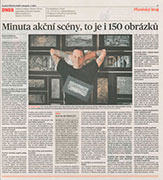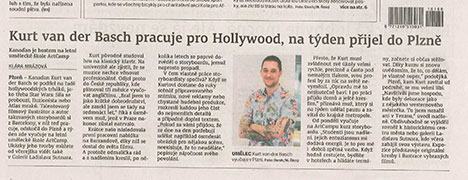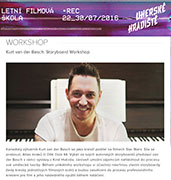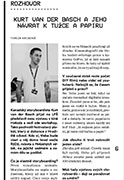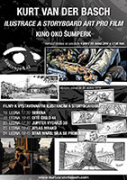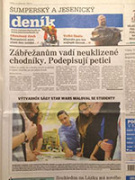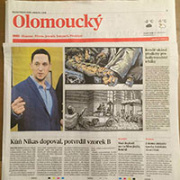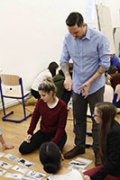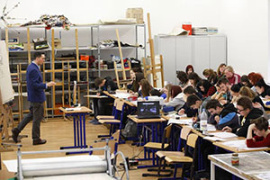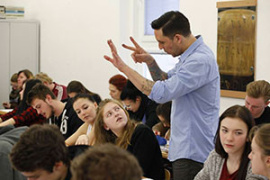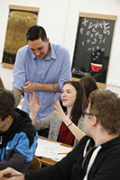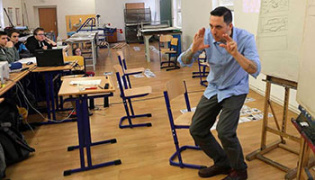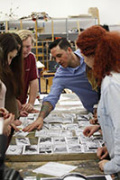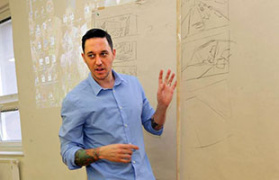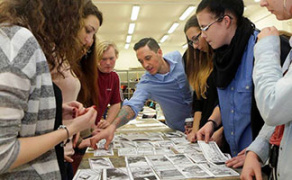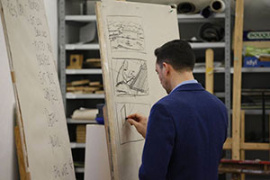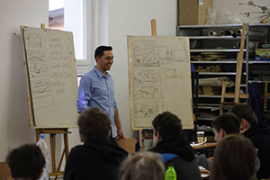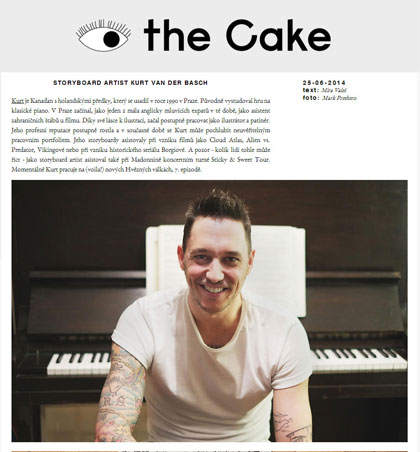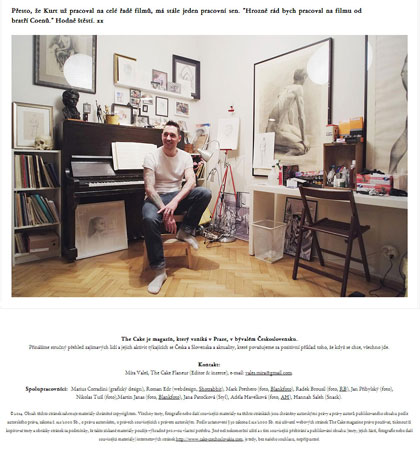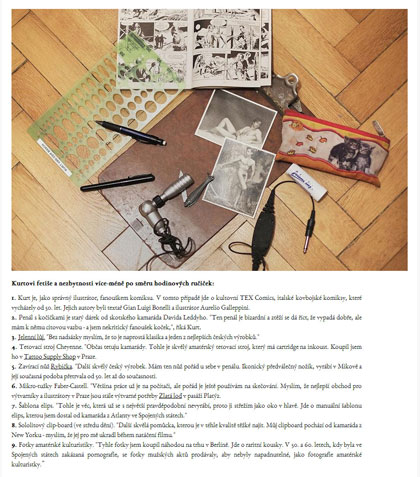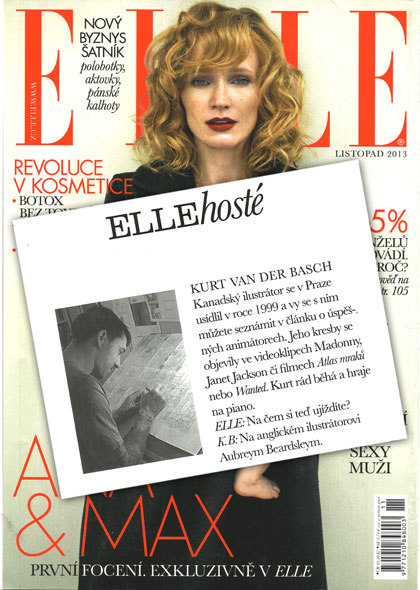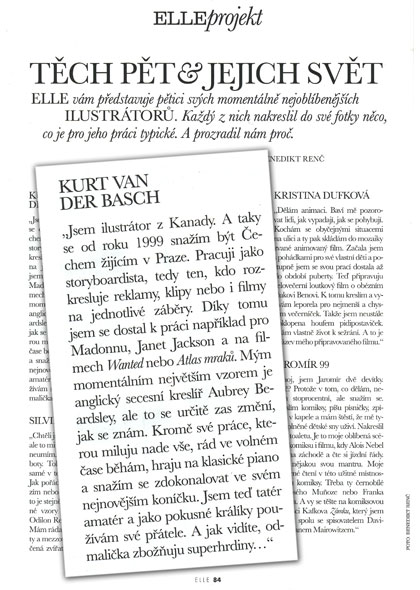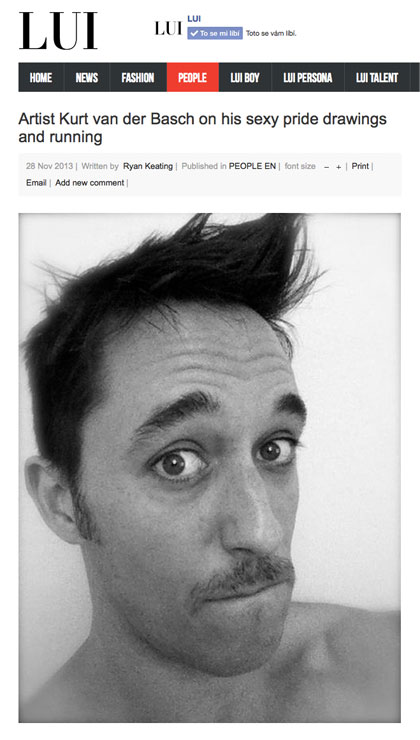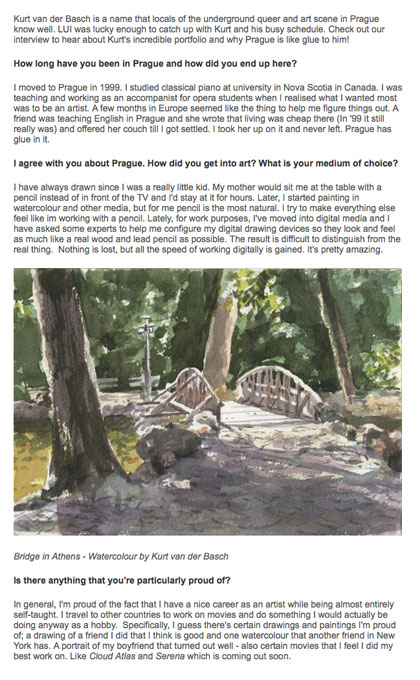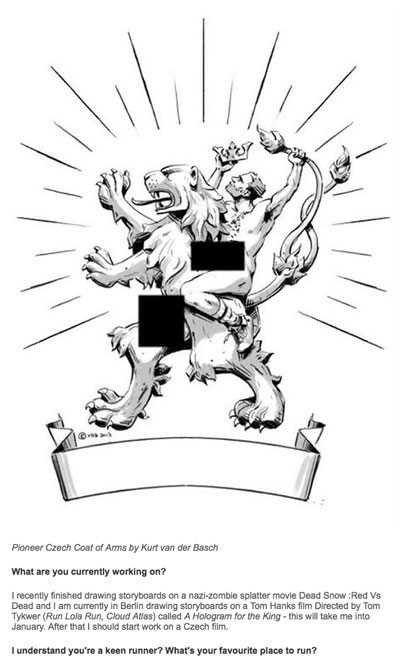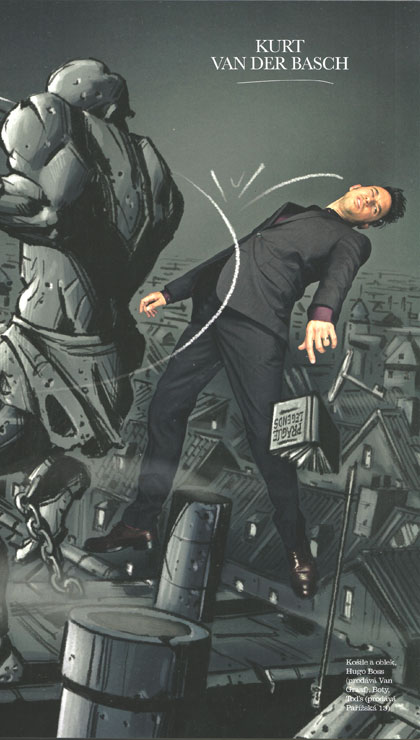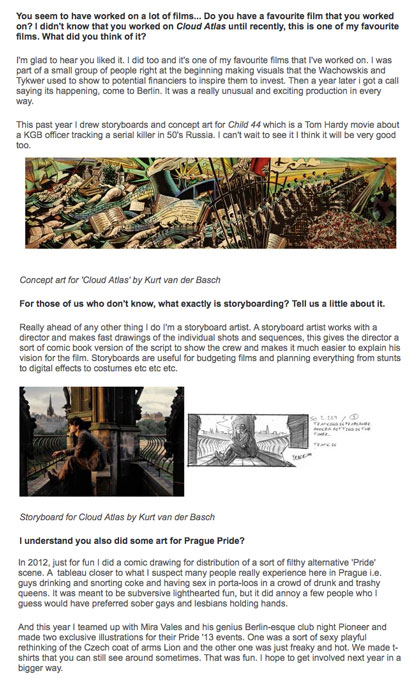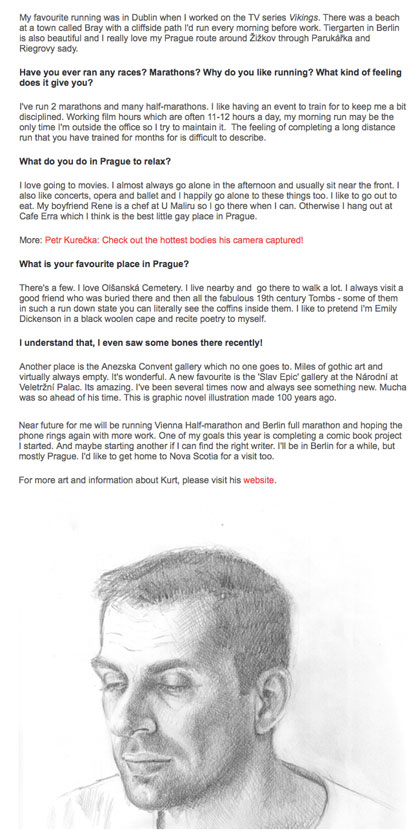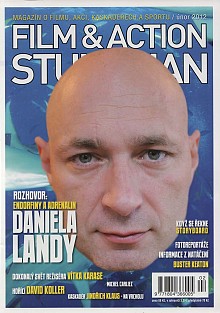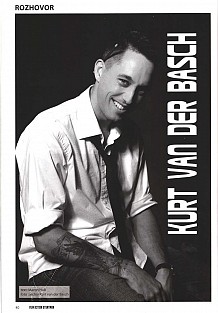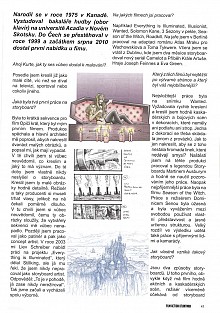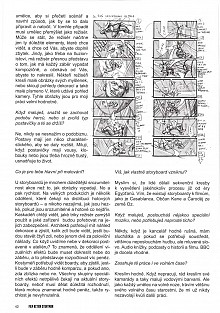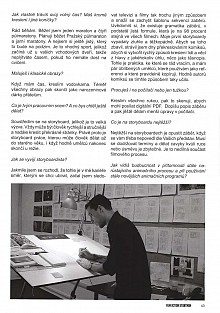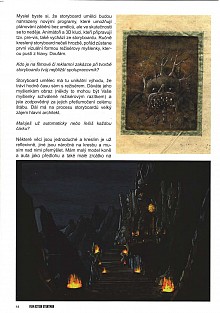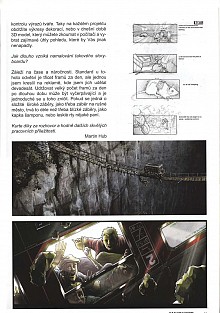- www.forbes.cz/drive-si-na-star-wars-hral-ted-vytvarnik-ze-smichova-kresli-jejich-sceny/
- www.ceskatelevize.cz/porady/1131721572-babylon/414236100152013/video/420048
- www.idnes.cz/zlin/zpravy/kreslir-kurt-van-der-basch-na-letni-filmove-skole-v-uherskem-hradisti.A160726_2262076_zlin-zpravy_ras
- reportermagazin.cz/a/idKaT/kurt-van-der-basch-jak-nacrtnout-hvezdne-valky
- www.youtube.com/watch?v=u4kZV4ebR6U
- www.youtube.com/watch?v=ukOAU1x1IzM
- www.cbc.ca/news/canada/nova-scotia/nova-scotia-artist-kurt-van-der-basch-is-storyboard-artist-for-big-movies-1.3394967
- www.tyden.cz/rubriky/kultura/film/kreslir-kurt-van-der-basch-se-pri-star-wars-vratil-do-detstvi_391878.html
- www.lui.cz/ostatni/item/2570-artist-kurt-van-der-basch-on-his-sexy-pride-drawings-and-running
- www.blesk.cz/clanek/zpravy-udalosti/543163/v-praze-jsem-se-zasekl-na-20-let-rika-kurt-ktery-pracuje-pro-hollywood.html
- ssum.cz/2018/03/06/workshop-kurtem-van-der-basch/
- www.youtube.com/watch?v=hlG56-3xSPU
- www.youtube.com/watch?v=v4is4J1Gbdo
- www.youtube.com/watch?v=Dhx7JWvxbEE
- www.youtube.com/watch?v=ukOAU1x1IzM
- www.youtube.com/watch?v=tHGJqx6LvtI
- www.youtube.com/watch?v=epy_jDr67A0
- www.youtube.com/watch?v=u4kZV4ebR6U
Interview with Storyboard Artist Kurt Van der Basch (Star Wars Episodes VII and VIII)
A storyboard artist, or story artist, creates storyboards for film productions that are generally for large scope scenes, actions, and/or camera movements. The artist visualizes the story in collaboration with the director and sketches frames of the story on paper.
It was an honor to sit down with the brilliant storyboard artist Kurt Van der Basch, who worked on Star Wars: Episode VII. Of course he’s not allowed to talk about it, which is fine because there are so many other questions to ask him.
Please go to his website or follow him on Facebook and view 100s of storyboards from his various credits, including: Assassin’s Creed, Sense8, The Borgias, Chronicles of Narnia, and The Illusionist, to name a few.
www.facebook.com/kurtvanderbaschstoryboards
www.kurtvanderbasch.com
Matthew Toffolo: I understand that you are not allowed to talk about Star Wars! No problem. Are you allowed to say that you had a creatively inspiring experience?
Kurt Van Der Basch: Yes, I can definitely confirm that it was a creatively inspiring experience and I loved the result as much as everyone else seems to have.
Matthew: Looking at your storyboard examples on your website your storyboards are so visual and amazing to look at. I see the story unfold by just looking at the images. They are like a graphic novel that could be published. Do you have any (or many) graphic novel ideas?
Kurt: Thanks a lot. Sequential illustration is sequential illustration whether it’s in the rougher form of storyboards (usually, at least) or in the ready-for-publication form of a graphic novel. We more or less tell stories the same way in both fields. It’s interesting too that with the growing popularity of graphic novels and the rise of DVD extras that storyboards, interest in storyboard art has grown a lot. Now lots of people know what they are and are keen to see them. As for graphic novel ideas – I have lots of but I don’t consider myself much of a writer. I’m still waiting for ‘the perfect fit’ with a writer who wants to collaborate.
Matthew: What’s the general working relationship and process between a storyboard artist and the director? How early do you meet before production begins?
Kurt: The storyboard artist can often be among the first crew mambers to start. I did a long job this past year where I was one of the first 3 people hired then slowly more and more crew joined the production. Early on, there’s generally a list of the most complicated scenes which the production need storyboarded for budgeting and planning purposes listed from highest priority to least. In these discussions the 1st Assistant Director is a key player and as the production goes on, it’s the 1st A.D. who always knows best what’s most urgent and what the latest developments are.
Usually the storyboard artist has daily storyboard meetings with the director (Often arranged by the 1st AD. As the production grows and the director begins to be yanked in a million directions these meetings may not be so frequent) and they sit down and discuss the scene. Often the director will start by showing some references, video clips or still images that they think could be a good style or tone guide. If there’s already a production designer then he or she may provide location photos or a model (either a white card one or, more commonly these days, a digital sketch-up model) so we have a geography to work with. Then the director will begin to describe shots of the sequence. While the director is describing the shots I draw quick little thumbnail sketches so the director can intercept and say, for instance, ’no, a little bit wider’ or ‘could it be a slightly higher angle?’ etc. until I am drawing what he or she is envisaging. It’s common dirng these meetings to draw a little plan view and indicate on it camera and characters too. Some directors will dictate every shot of each sequence that gets storyboarded, but, especially on huge action movies where it’s nearly impossible for the director to arrive with all the shots of each scene planned out in their head in advance, some directors encourage the storyboard artist to make suggestions or even ask them to have a crack at the whole scene as they see it. Then the director can react to those ideas and say ‘yes that’s interesting, keep that, but here I thought we could….’ etc. This can be a fun and creative way to work. Later in the production these meetings often include the DoP as well. As time permits the little thumbnails drawn during the meeting are taken away and the storyboard artist makes more clear and solid versions of them with directional arrows and shot descriptions added next to the panels, plus proper scene and shot numbering. Sometimes time doesn’t permit and it’s necessary to settle for the rough thumbnail scribbled out in the meeting. Sometimes the director insists on the storyboards being left at the rough stage so the crew won’t take particularities of the drawings too literally.
Matthew: When talking about the cinematic design with the director, is the overall theme and tone of the film always present in each storyboard you create?
Kurt: It can be but isn’t always. Sometime it’s very technical and the most important thing is just to clearly show a certain camera move + character action. If your drawing can convey a bit of the atmosphere in these instances that’s great but not if it takes away the clarity.
Matthew: How is the process different when doing a TV episode assignment in comparison to working on a feature film?
Kurt: TV production usually doesnt have the luxury of pre-production time that film has. From what I’ve seen TV directors tend to behave and are treated much more as regular crew members and in my experience TV directors tend to be extremely focussed and organised knowing how little time they will have to complete their block of episodes (on a series the directors usually trade off in ‘blocks’ of episodes so while one is shooting their 2-3 episodes the other is prepping theirs.) The TV storyboard process can be more intense – longer hours and more frames per day, and often less ‘finished’ in order to get all the necessary sequences boarded before shooting. Also there’s less scope for spontaneous ideas – a sudden brilliant suggestion of a shot from inside the microwave can’t just be thrown in in TV world without serious consideration of the extra time and cost etc. I really enjoy storyboarding for TV.
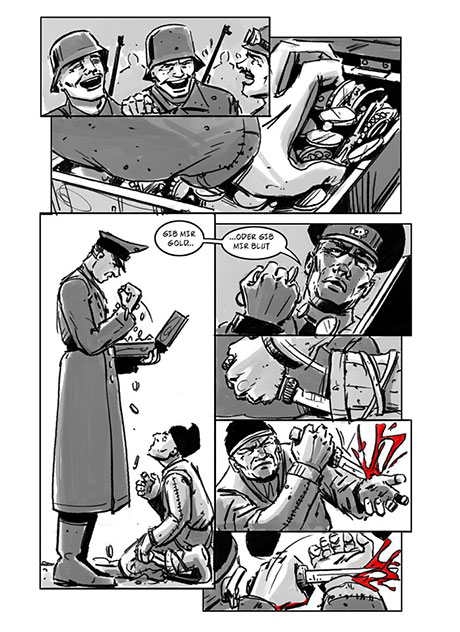
Storyboard from DEAD SNOW 2 (2014), Director Tommy Wirkola
Matthew: What are you looking for in a director?
Kurt: Well the question is really what are they looking for in me because it’s me who is hoping to get hired. But if they do pick me then I look for patterns in how they describe things so I can get to sense what they probably will want as quickly as possible. For some directors articulating the shots they need isn’t as easy as it is for others and it’s the storyboard artist’s job to help with this. This is where the thumbnailing process can be great. Sometimes seeing my totally wrong scribble can be the very thing that helps a director get across the shot in his or her head. On the other hand I’ve worked with directors who draw beautifully and make perfect thumbnails that are a very clear guide that I then just have to draw up in a more finished way.
Matthew: Do you have a Storyboard mentor?
Kurt: The Engish storyboard and strip cartoon artist Martin Asbury essentially created a whole style and standard in the industry that influenced a whole generation of storyboard artists, at least here in UK/Europe. I’ve been lucky enough to work with him twice and both were great experiences. On top of being a huge talent he’s also a really funny and generous man.
Matthew: You have worked on a lot of Action, Fantasy, and Horror films. How important is the creation of the storyboard to the production team for these genres?
Kurt: In an action movie there’ll be two or three big sequences that the storyboard artist works on and sometimes just these scenes may be revised over and over the entire time on the job.
Storyboarding is more important for these genres than others because of all the VFX and stunts involved. Storyboards are neessary initially for making a budget because it answers questions like: In how many shots do we see the flying ship? How often does the camera tilt up enough to require digital set extension? Do we see the stuntman land or does he just fly off the roof? etc. Often it goes that once boards are made of scenes and compared with the budget then the producers then get out their sharpies and start crossing out shots that the production can’t afford. Then it becomes a discussion of where to use the VFX bdget to best advantage. Of course storyboards are also needed in these genres beyond just technicalities but to give an idea of a scene overall and know if it works in terms of drama and suspense. For this, sometimes the individual storyboard frames are plugged into editing software to make a ‘board-o-matic’ that plays the frames in order with timing and added music and sound effects. This can really give a feeling of the final sequence before it’s actually shot. There are some great examples of this on You Tube from Captain America.
Matthew: The film “Serena”, starring Bradley Cooper and Jennifer Lawrence is almost a lost film. Many film fans don’t even know it exists despite the all-star cast. The film is also a bit of a departure for you as it’s a straight up drama. Can you tell us your experiences working on that film and how working on a drama is different from the action/movement movies you generally work on?
Kurt: It’s the strangest thing isn’t it? I think it’s a good movie yet it took ages to be released and even then it was very limited. I was hired in this case by the production designer Richard Bridgland who I had worked for on Alien vs Predator. I did ink and marker illustrations of all his sets for presentation to the director Susanne Bier and then when my job was done the production asked if I could stay on as a storyboard artist as there were a few scenes where it moved out of the relam of straight-up drama and needed storyboarding. An accident on the cutting slope of a logging camp involving trains and falling trees and later a sort of chase scene and fight.
Storyboard from CLOUD ATLAS (2012), Directors Tom Tykwer, Andy & Lany Wachowski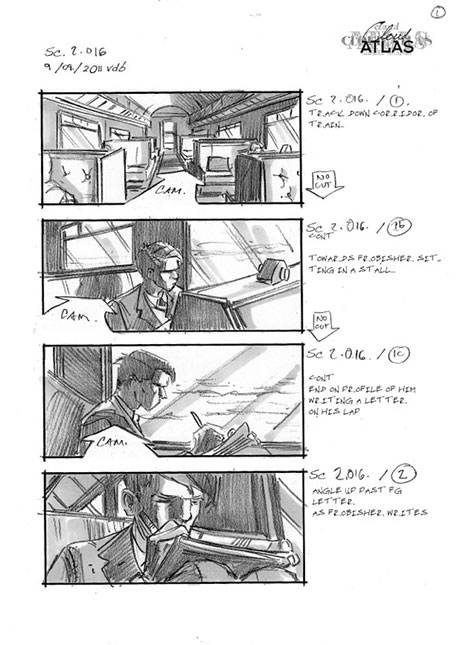
Storyboard from SERENA (2014), Director Susanne Bier
Matthew: Besides the films you’ve worked on, what movie have you seen the most in your life?
Kurt: Definitely ‘The Exorcist’. But a close second is the annual holiday showing of ‘The Sound of Music’ which is a Canadian tradition since before I can remember. I also know most of ‘Mommy Dearest’ by heart.
Matthew: You have worked on over 40 productions in the last 15 years. Do you have a favorite experience?
Kurt: Working on ‘Cloud Atlas’ was probably the most memorable. It was just such a great group of people over in Berlin and the script is magic to me. So ambitious and crazy but they pulled it off. I also did a sci-fi short called ‘A Living Soul’ with the Swedish director Henry Moore Selder that was really cool. On a short there’s limited money and the storyboards make a huge difference to the production. We did about 400 frames in 2.5 days on that project and the result, I think, is fantastic.

Storyboard from CLOUD ATLAS (2012), Directors Tom Tykwer, Andy & Lany Wachowski
Matthew: What director would you love to work with that you haven’t worked with yet?
Kurt: There’s a few. Maybe when Xavier Dolan makes an action or Sci-fi movie I’ll get to work on it. He’s a genius. And there’s also Ridley Scott!
Interviewer Matthew Toffolo is currently the CEO of the WILDsound FEEDBACK Film & Writing Festival. The festival that showcases 10-20 screenplay and story readings performed by professional actors every month. And the FEEDBACK Monthly Fesival held in downtown Toronto on the last Thursday of every single month. Go to www.wildsound.ca for more information and to submit your work to the festival. – matthewtoffolo.com/2016/01/23/interview-with-storyboard-artist-kurt-van-der-basch-star-wars-episodes-vii-and-viii/
Star Wars: The Force Awakens work was 'dream come true' for Nova Scotia artist
'I didn't really believe that it was happening,' says Kurt van der Basch
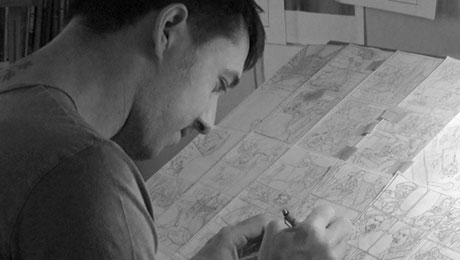
Kurt van der Basch is a Nova Scotia 'army brat' who was one of the storyboard artists who worked with some of the biggest names in movies. He was also one of the storyboard artists who worked on J.J. Abrams's Star Wars: The Force Awakens. (Photo by Miloslav Student)
A Nova Scotia man living in a country far, far away says having a hand in the biggest movie in the galaxy "was an absolute dream come true."
Kurt van der Basch is a storyboard artist who works out of Prague. One of his recent jobs was on a little movie you may have heard about — Star Wars: The Force Awakens.
The self-described "army brat" — who went to Cole Harbour District High School and then Acadia University — says ending up in the Czech Republic was "absolutely random."
"I did music at Acadia and then I decided I wanted to be a painter and see a bit of Europe," he said.
"As soon as I got to Prague I got a job in a movie and that [led to] another one. And after so many years, I'm still here."
For confidentiality reasons, van der Basch can't get talk about the specifics of working on Star Wars: The Force Awakens, but he said it "was an absolute dream come true."
"I was a huge Star Wars fan when I was a kid — just insane — so I didn't really believe that it was happening," he said.
J.J. Abrams made a movie 'for the fans'
A storyboard artist works with producers and directors to help them visualize stories and sketches, usually before production begins.
"The director explains how the story will look and the storyboard artist makes a little drawing of it. Every time there's a cut, you make a new little drawing.… And so it winds up looking like a comic book," said van der Basch.
"You could draw anywhere from 40 to 50 little frames per day. I mean, sometimes even more."
Van der Basch said working on The Force Awakens was a "totally unforgettable" experience.
"It was such a big deal and you're so invested in it, you really wanted to do your best — your absolutely best work," he said.
"You think you're never going to get a chance to do this movie again, whatever little part you have on it."
For van der Basch, working on the latest instalment in the Star Wars franchise is a twice in a lifetime experience. He also had a hand storyboarding one of the upcoming sequels.
"It's more than anyone could ask," he said.
He saw The Force Awakens with about a dozen of his family members in Nova Scotia over the holidays.
"I think J.J. [Abrams] is amazing. He had a really brilliant concept for it and everybody was on board to make it perfect. As he said so many times in interviews, he wanted to make this film for the fans," said van der Basch.
"He has reverence for the material and it shows."
Getting his start
Van der Basch started out as an assistant in an art department working on a movie, "basically making photocopies and tea."
"I met a couple of storyboard artists on different movies and I thought, 'This is an interesting job.' Because you have to be able to draw fast and that was something I was good at."
Then his break came.
Liev Schreiber, who has received multiple Emmy and Golden Globe nominations for his work on the Showtime drama Ray Donovan, was directing his first film, Everything is Illuminated.
"I was brought in for an interview and I said, 'I've never done this before,' and he said, 'Well, I've never done this before, so maybe we can do it together.'"
"He gave me my first chance, so that was really great."
Van der Basch said although working on Star Wars: The Force Awakens was an incredible experience, one of his favourite movies — among the ones he's been involved in — is the cerebral science fiction film Cloud Atlas, co-directed by the Wachowskis and German film director Tom Tykwer.
"It was incredible, especially because it wasn't a big studio picture, so you felt like everyone was doing everything they could to make it happen and I love the result," he said.
By Cassie Williams, CBC News – www.cbc.ca/news/canada/nova-scotia/star-wars-force-awakens-nova-scotia-storyboard-artist-1.3394945

Film artist Kurt on Sense8 and other work
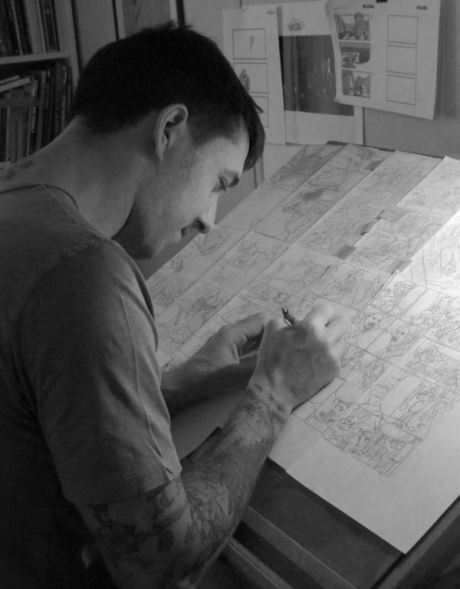
Concept and storyboard film artist Kurt van der Basch is surely a name that many in the Prague art and film scene would recognise. Originally from Canada, he moved to Prague to pursue a career in art which inevitably led him to film. Like many of us expats, he began teaching English. Kurt’s journey and career has been incredibly diverse and I’ve personally been looking forward to this interview for some time. On top of that, I’m also a major movie nerd so editing and listening back to this interview took a while – there were moments that I had to say to myself ‘Ryan, just shut up…” From working on recent Prague based films like Child 44 to sketching 100s of storyboard frames for the new Netflix series Sense8, there are some interesting insights into the film industry in Prague, and Central Europe… Not to mention some of Kurt’s early obsessions that got him into drawing in the first place. Enjoy!
Where are you from originally?
The east coast of Canada, Nova Scotia.. Halifax. Well, not really from Halifax, but from a suburban little town near there…. But we moved around a lot.
And what are your greatest memories of growing up in that part of Canada?
The landscape and the weather. The long winters, meter-high snow.
Do you miss the snow?
Sure, because I’m not into driving so it’s never really affected my day. I just love it. And there’s something cozy about the snow reflecting off the ceiling too – it kind of lights up a whole room.
What did you want to be when you were a kid?
I really wanted to be an Egyptologist. I had that worked out for years. I took it so seriously. I even had a newspaper cut-out of me somewhere saying “I want to be an Egyptologist” when I was about 12. 1986 I think it was. There are actually a lot of Czech egyptologists. It’s a specialty here, it’s always been a dream to go there but it would be really hard now.
When did you get into drawing?
I was always into it, as far as I can remember. I was always into drawing black and white, in pencil. My Mum would just sit me down and I would draw.
And what would you draw?
Well, I would obsess and draw one thing over and over again. I had a mermaid obsession, and the egyptology was a part of a lot of the stuff that I would draw too – I think that had a big impact on my drawing because it was so graphic and standardised. You know, a hand always looks exactly the same, so does a foot. So I’d really try and nail it. But then I got into music which became a huge diversion in my life. So then I would draw pictures of Beethoven over and over and over.
That’s really nice. To be so young and drawing Beethoven? That’s quite unheard of.
When I was 12 I broke my arm doing gymnastics in rubber boots on the grass… the wet grass (laughs). And it hurt so badly – it was coming out at a 90 degree angle.
Ouch!
Yes.. anyhow, I was in the cast for about a year and when I got it off I met a girl who played the piano and she was really good and she taught me some Beethoven so then I became obsessed. So my parents got me a used piano and a teacher. And as an obsessive gay boy with no friends, I would go home and practice and practice and all of a sudden I went from a total beginner to quite advanced in just a few years. Then I went to university and studied music. Everything was music. But the whole time I was drawing and drawing and drawing. You know, we have sort of a romantic idea of artists – that they should suffer and it should be really hard, and practise 7 hours a day. A lot of people, including me, find that very attractive. So I was a good artist, but because it came easily to me and there was no romantic suffering involved, I didn’t feel like it was a very special skill. The whole time my Mum was saying “why don’t you go to art school?” and I thought “please, I’m a pianist” (laughs). So then in my third year of studies I realised that I wasn’t mean to be a pianist, but an artist.
How did you get to Prague?
I was finishing music at university, and I sort of wished that I wasn’t because I wanted to be an artist. Originally I thought I wanted to be a painter, so I thought I had to go to Europe. I had a friend, Moira, who had moved to Prague to teach English, so I just copied her and came here to teach for three months and then all these fateful things happened… and that’s why I’m still here 16 years later.
Wow, a long time.
Yeah, I arrived the summer of 99.
That almost sounds like that Bryan Adams song.
Yes! Canadians roll their eyes at Bryan Adams, because he’s Canadian. We often give people from our own country a hard time.
How did you make this transition from teaching into art?
It’s so weird, you know when you think, oh god if I hadn’t met that person at that time.
Sure.
I had a friend who was a teacher and he had a friend who was working for Barrandov studios here. And she said that she knew some guys doing a movie who needed an art department assistant… Which means tea and photocopies but you have to sort of know something about art. So we got in touch and I brought them my sketchbook and they gave me the job, and yeah I did a lot of tea and a lot of coffee. But it was a fantasy movie and one time some things needed to be designed and drawn up earlier so they gave me a chance at it. So I just kept drawing and making photocopies. I could draw and also speak Czech which was good for them. Eventually I became a set painter and did that for three jobs and it was so great, I could have almost done that as a career actually. You’re filthy all the time and building scaffolding and stuff.
It’s nice to be able to use your hands like that.
Yeah, it was really great and we would go for lunch together and some people wouldn’t let us in because we were so dirty and black. 90% of what you paint is black. When we did Blade 2 we had to paint a big tunnel that was just hundreds of metres of white plaster bricks that we needed to paint to look like real bricks. Brick, brick, brick, brick (laughs).
(Laughs) Could get a little monotonous?
Monotonous but fun and the guys we worked with were really great. At the end of the day I just wanted to draw, so I left the set painting and got into the illustration side of film making.
How long did it take you to learn Czech?
Well I met my boyfriend after working here for two months and he didn’t speak any English – we’re still together after 16 years. I was gung ho because I’d just arrived and wanted to learn Czech. But you learn Czech mainly from arguments, so you know I would write words on my hand to arm myself for the next argument, like “irresponsible” (laughs). Hmmm I have to remember to say that to him. And I worked in bars too where my Czech improved a lot.
At what point did you think “I’ve made it, I’m living out a dream job”
The first time I saw my name in the credits, that was pretty cool. But cooler than that was the first time my parents and my sister saw my name in a credited movie that they went to the cinema to see. That was really cool.
Would you have any advice for other expats that come here and want to pursue their dreams?
Well, for me it was really useful to learn the language. I mean in Holland or Germany it’s hard to learn because everyone speaks English, but here it’s possible to learn it and really integrate with it. So that’s a big one. Learn the language. And also to get friends who are Czech.
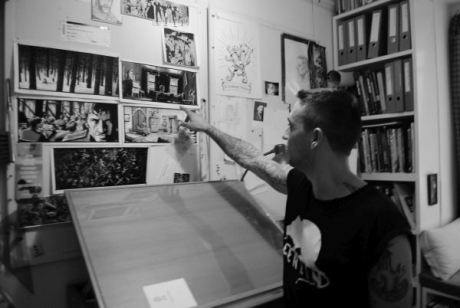
What are some of your fondest memories on film sets?
Me and my friend Chris who also works in the movies, we worked on this movie Doom and we were doing this bio lab filled with hearts and lungs, and a veiny dildo that we snuck into the background :) Anyway, we rigged them up with LEDs, it looked really cool. And during the filming we had to lie under the tables aqueezing air pumps to make them beat and move which was great. So that was a funny one.
(Laughs) That sounds brilliant. Now from what I understand, you’ve worked with some directors and filmmakers more than once. Tell us about some of them.
Well I have worked with Tom Tykwer on several things now and through him Wachowskis. Tykwer always uses the same team who I met on Season of the Witch. That was an amazing gig in Budapest but I also just fell in love with this art department and we’re really close now. And it was around this time that Tykwer’s designer Uli Hanisch said I had to buy this book called ‘Cloud Atlas’. This was in 2008 and he said a movie might happen, and then a couple of years later it did so I went over to Berlin to do a week long illustration workshop and then they used this as a pitch for the studios while the Wachowskis were doing the same thing with their art department in Chicago. Then a couple of years later it happened. I also had a job working with a Dutch designer on a children’s film. We really hit it off together so I’ve worked with him a bit. And there are also some commercial directors I always go back to, particularly those who specialise in hair. So for a long time the only commercials I did were hair commercials. Have I told you about this hair world?
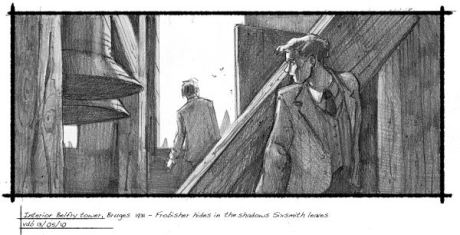
Cloud Atlas
No, please do.
Well with these hair commercials, the directors really guard their tricks. There is this one trick where they use a phantom slowmotion camera and there is this big rig that the hair model sits in like a guillotine with all these holes in it and they’ll bring the hair up in strands and spend about an hour setting this up. Then when they drop it, the weights fall down and it flies into the air and you think her head’s going to come off but instead the hair falls in these beautiful individual locks that they catch with a phantom camera. Then you get this slow beautiful Lars Von Trier look (laughs). They always want to use the same people, it’s very close. Commercials are great.
Now, you worked on Child 44 that was released recently, and it was actually filmed in Prague. For people that see the movie, can they recognise Prague there?
Constantly. Any exterior, even if you can’t see exactly where it’s done, you can still tell the sidewalk or a doorway and know that it’s Prague.
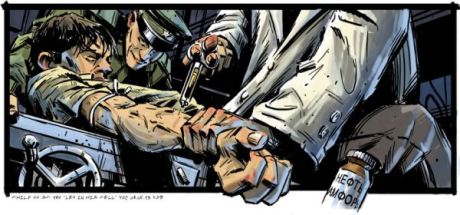
Child 44
I really look forward to seeing it. So, tell us about Sense8. Everyone is talking about this on the internet at the moment.
Wow, Sense8 is crazy. The crew said it was the hardest job they have ever done. It was filmed in Nairobi, Berlin, Chicago, Deli, Iceland.. everywhere. But I only worked on the Tykwer parts in Berlin, there was a director for each section. I think it looks really good, the trailers look great. Also Darryl Hannah seems so interesting and weird. All the crew on Sense8 pulled really long hours – I did too. For scheduling and budget reasons, Tom Tykwer could only bring me over to Berlin for a few days with the plan to storyboad only the trickiest action sequences but as we were considering them there was always one more and one more that would be great to have boarded out. SO in the end we were hammering them out in rough form at an incredible speed. I did more frames per day on this job than I ever have on any other one. I counted 280 drawings in 3 days. Though it shows! They’re awful but they do the job. It’s great to see how positive the reaction to the show is after the divided reception of Jupiter Ascending (another Wachowski film) and Cloud Atlas.
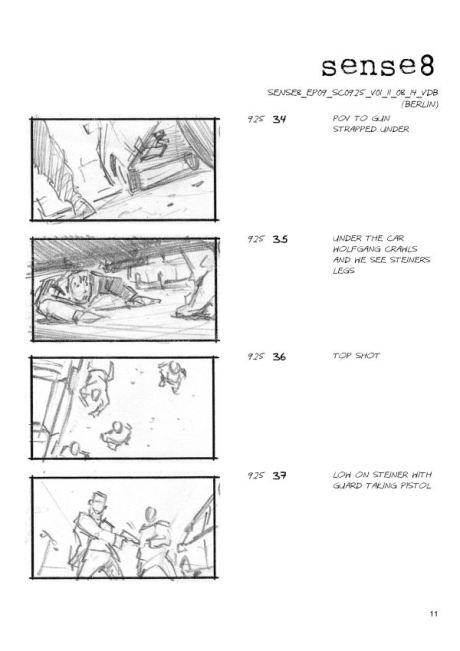
I think your hard work paid off. What work are you most proud of so far?
Cloud Atlas definitely. I think it’s a masterpiece. And as far as drawing work goes I really liked what I did on Child 44. I was quite impatient for that to come out. And also Jupiter Ascending. There were over 30 concept artists on that film.

Cloud Atlas Mural
It was stunning, and I also remember seeing the Prague dancing house in that movie!
Yeah! I noticed that too! That was funny. It really worked in that scene and in that environment, it doesn’t work here in Prague.
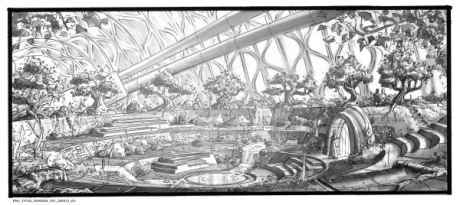
Jupiter Ascending
You don’t like it?
No, I don’t. It sticks out like a sore thumb. I think it’s arrogant to take such a beautiful vista and do something so attention-grabbing. I also did a comic book prologue for Dead Snow 2 which they passed out at Norwegian cinemas – that was nice.
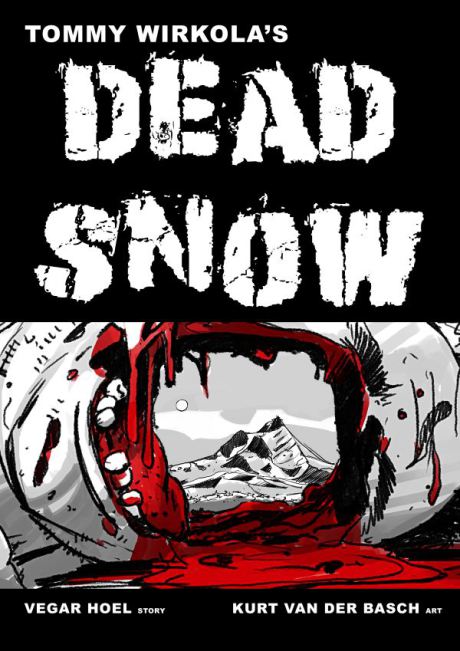
I also saw on IMDB that you worked on the new Star Wars.. What can you tell me about that?
Nothing at all. The NDA on that job is major.
And what are you working on at the moment?
I’ve been in London for nearly six months on a big studio movie with another crazy strict NDA so you’ll have to wait for it to come out :) Something else I’ve worked on that is due to come out soon is a Tom Tykwer and Tom Hanks film called A Hologram for the King. That was a really enjoyable Berlin job and I think it will be a good movie.
For the first time this July I’m also teaching a one week course at the university of West Bohemia about storyboard illustration and I’m very nervous about it.
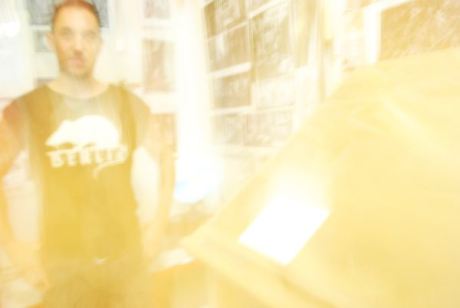
Sounds great! I’m sure you’ll be fine. How would you describe Prague in a few brief words?
Prague is trashy and chic all at once – a great combination.
If you could go back in time and see anything, what would you see?
I would love to go back to ancient Egypt or late 18th century Vienna with Beethoven and Mozart around. That’d be really cool.
What is your favorite word in English and in Czech?
Does Polari count as English? Because I do like ‘Zhoosh’. In Czech I think Jejda is funny.
Who would play you in a movie about your life?
Some friends used to say I looked like Jonathan Rhys Myers, which I didn’t see. But then recently there were some pictures of him looking puffy and sad drinking straight out of a bottle of vodka on the street and I thought ok now I can sort of see it (laughs).
Where do you like hanging out in Prague?
Well actually I’m not a big hanger-outerer. Once in a while I go crazy but I spend a lot of time on my own. I really need it. So I hang out in our kitchen with our three cats a lot (laughs) and I also like going to the movies a lot. I’m also learning to play the accordion.
Keep updated with Kurt’s work on his Facebook page.
Check out the Sense8 trailer below:
Written by Ryan Keating-Lambert. Photos by Ryan Keating-Lambert and Kurt van der Basch.
PechaKucha Night, Plzen October 2014
Cloud Atlas > Storyboard a artwork přímo od spolutvůrce
Někdy se vám přihodí, že někoho znáte z večírků spoustu let, aniž by jste vlastně věděli, čím se ten váš známý či kamarád vlastně živí. U mě je to dáno tím, že se zcela programově snažím při zábavě ukázkově neamericky vyhýbat rozhovorům o práci. Podobnou osobní zkušenost tak mám naposledy s Kanaďanem Kurtem van der Baschem (37), který žije pěknou řádku let v Praze, a o kterém jsem až relativně nedávno zjistil, že se živí jako profesionální ilustrátor, concept artist a storyboarder. A byl jedním z těch, kteří se podíleli na aktuálně v kinech běžícím filmovém projektu sourozenců Wachovskich a Toma Tykwera – Cloud Atlas, který jsem nedávno recenzoval zde.
Vzhledem k tomu, že naše smečka iluminátů z BiggBoss potřebuje neustále další a další „potravu pro hlavu“, poprosil jsem ho o pár slov k jeho dosavadní práci i ke Cloud Atlas. Kurt je výtvarný samouk, který se naučil kreslit nejprve „obkreslováním“ obrazů a kreseb, které se mu líbili a posléze skicováním přátel a věcí, které ho obkloupují. Což ostatně dělá dodnes. „Jako dítě jsem byl inspirován ilustracemi Maurice Sendaka v dětských knihách, které jsem tehdy četl….Miluju kresby komiksových umělců: Jim Lee, Harry Bush, Moebius, Richard Guerineau nebo starých malířů jakými byli například John Singer Sargent či Aubrey Beardsley,“ popisuje Kurt svoji inspiraci v mailech, které jsme si kvůli tomuto článku vyměnili. K práci tvůrce storyboardů se dostal tak, že na konci 90.let v Praze začal dělat pomocníka u filmu – runnera, který dělal s kopírkou a nosil kafe. Pak náhodou nebyl nikdo, kdo by něco nakreslil a z asistenta všech se začal stávat profesionální umělec, který se podílel na v Čechách natáčených Bratrech Grimmech (The Brothers Grimm) od Terryho Gilliama či holandské pohádce Foeksia de Miniheks (Malá čarodějnice Foeksia). Specificky tu si dodnes pochvaluje, protože filmaři ztvárnili scény naprosto přesně podle jeho návrhových kreseb.
Jak se dostal k Atlasu mraků? „V roce 2008, na konci projektu Season of the Witch v Budapešti se mě designer Uli Hanisch zeptal, zda jsem četl kníhu Atlas mraků – a pokud ne, měl bych si ji hned přečíst. Podle něj se totiž brzo mělo začít pracovat na její filmové adaptaci. Přečetl jsem ji a byl jsem okamžitě fascinován,“ vzpomíná dnes. Po dvou letech mu zavolali z Berlína, aby se zúčastnil spolu s dalšími dvěma umělci několika týdnů práce na projektu. Tom Tykwer a Wachovští knihu již přepracovali na scénář a sháněli na tento obrovský projekt sami peníze. „Takže potřebovali obrázky, aby možným investorům ukázali příběh a to, jak jejich peníze budou vypadat na plátně. Každý tým pracoval na třech částech z šesti dílného příběhu,“ vypráví Kurt genezi vzniku filmu.(Kurt pracoval na části Toma Tykwera a jeho týmu z filmu Perfume v Berlíně, Wachovští se svým týmem v USA tak, že dohromady vznikla skvělá prezentace a rok později začala i samotná preprodukce, na které se již řešily konkrétní lokace a storyboard. „Cítil jsem, že srdce všech byly opravdu upřímně do celého projektu ponořeny, a že je to na plátně vidět,“ dodává k Atlasu mraků.
A do jaké míry se promítá umělecké ztvárnění autora do podoby storyboardů a filmu? „Často ti režisér vysvětlí děj či akci a možná ukáže obrázky či scény z dalších filmů, které ho inspirovaly. Někdy bývá velmi exaktní včetně kompozice a naoppak v jiných případech (speciálně v akčních filmech) má režisér méně času vysvětlovat každý záběr. Takže třeba jen popíše některé věci a momenty, které v záběru určitě chce, ale zbytek nechá na storyboard artistovi. A jindy bývá režisér dokonce zaneprázděný dalšími věcmi tak moc, že prostě přijde a řekne: přeči si scénář a nakresli ho.“
Kurt van der Basch v posledních letech pracuje na svém samostatném projektu, který by nebyl předstupněm pro něco dalšího, ale jeho samostatným dílem. „Vyvíjím vlastni komiksové a kreslené románové náměty s několika dalšími spisovateli. Jeden z těchto projektů bude doufám zcela celý v češtině.“
Big up, držíme palce a doufáme, že nám o něm dá včas vědět.
http://www.kurtvanderbasch.com
https://www.facebook.com/pages/Kurt-van-der-Basch-storyboards-and-illustration/165609296915520?fref=ts
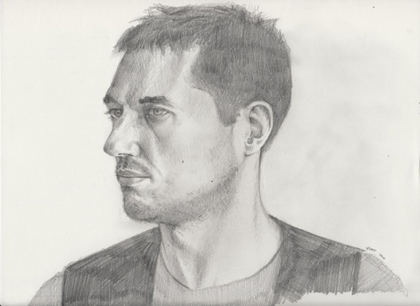
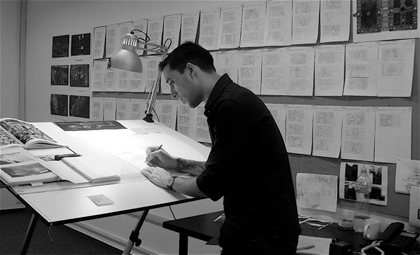
Kometáře k storyboardům by Kurt van der Basch, images: Kurt van der Basch / Warner Bros
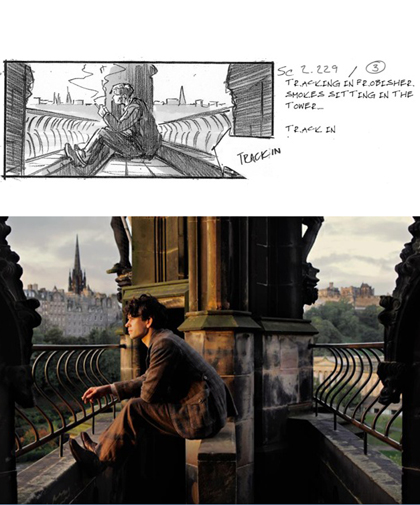
Cloud Atlas (image: Warner Bros) Ben Whishaw jako Robert Frobisher, skladatel z 30.let, sedí v Edinburghské věži u svítání. Ve filmu se snímek ze storyboardu na plátno přenesl velmi podobně. Šipka indikuje pohyb kamery směrem k němu. To vytváří napětí.
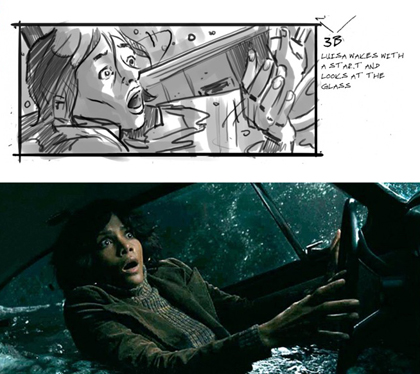
Cloud Atlas (image: Warner Bros) Halle Berry jako Luisa Ray, Tato scéna auta padajícho do vody vyžadovala hodně plánování kvůli zvláštním efektům a každý záběr byl rozkreslen do detailů před natáčením tak, aby se předešlo jakýmkoli pochybnostem a problémům dopředu.
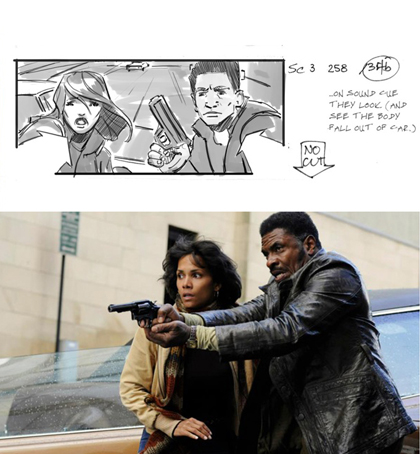
Cloud Atlas (image: Warner Bros) Další akční scéna. Honička v San Franciscu (natáčeno v Glasgow, UK). Storyboar pro tuto scénu byl spíše na blokování akce a úhlů. Je vidět, že o přesné snímkování záběrů rozhodl kameraman a režisér až na místě.
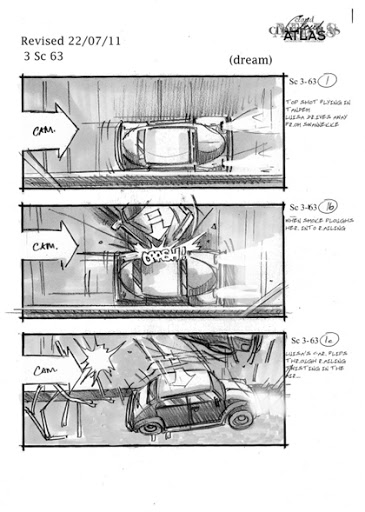
Cloud Atlas (image: Warner Bros) Storyboardová sekvence pro obtížný vizuální efekt – auto je odtlačeno z mostu. Šipky označují pohyby kamery a auta.
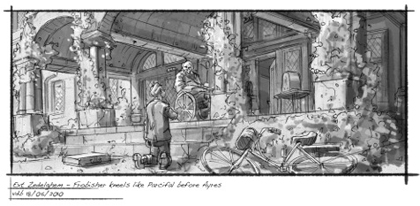
Cloud Atlas (image: Warner Bros) Velmi ranná skica z plánování v roce 2010. Byla nakonec vystrižena.
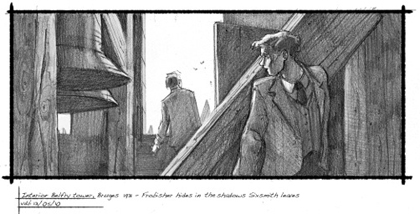
Cloud Atlas (image: Warner Bros) další kresba z plánovací fáze. Předpokládaný interiér zvonice v belgických Brugách. Nakonec byla celá tato sekce adaptována na Edinburgh.
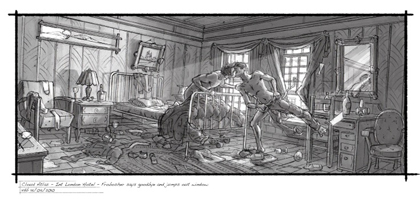
Cloud Atlas (image: Warner Bros) Konec milostné scény. Dva mladí muži se líbají předtím než jeden z nich zmizí oknem. Později jsme tuto scénu překreslili na skutečný hotelový pokoj v lokaci Berlín (i když exteriér pokoje se natáčel v UK.

Cloud Atlas (image: Warner Bros) murál spojující šest příběhů. Bylo začleněno do pozadí řady scén ve filmu a použito na oficiálních stránkách hudby k filmu Warner Bros Cloud Atlas music site.
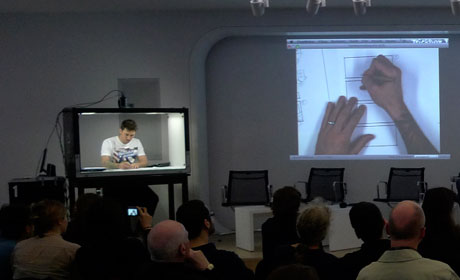
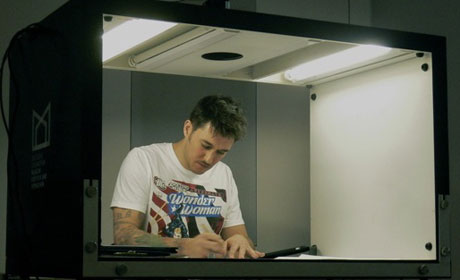
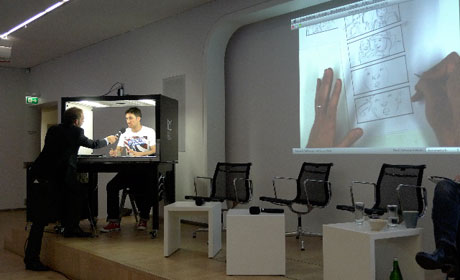
Photo courtesy Kristina Jaspers, Museum für Film und Fernsehen, Berlin.
In the Autumn of 2011 Kurt was invited to Berlin to participate in a special live-drawing public presentation of storyboard art for the German "Museum für Film und Fernsehen" exhibition: "ZWISCHEN FILM UND KUNST – STORYBOARDS VON HITCHCOCK BIS SPIELBERG".
In winter 2012 Kurt was interviewed for the Czech language magazine "Film & Action Stuntman" (Martin Hub). An English translation of the interview follows the pages.
Hi Kurt, when did you start drawing?
I have drawn obsessively ever since I was a child. more than tv or sports or anything.
When did you first find out about storyboards and what was your first job?
It was a short sequence for Monkey King my forst job in film. They were in a rush and The production designer asked me to draw 12 little pictures and he described when they need to look like. At the time I didn’t realize what it was or what its purpose was. I had never even heard of a storyboard. I did very detailed little drawings. The director and producers must have been pulling out their hair waiting for them. the 12 pictures took me all day. At that time i had no idea what they were for. and i didnt even recognize that it was a sequence really. Later I worked like a patiner and then a concept artist. but in 2003 Liev Schreiber gave me the job on the Stillking film Everything is Illuminated. I told him I'd never drawn storybaords. He said "that's ok I;ve never diorected" and so we got along fine.
What films have you worked on? Which weere the hardest from the design standpoint and which were your favourite?
The most difficult work was on WANTED. It required VERY fast drawing and lots of stunt/fight scenes in sets that really had no top or bottom. one set was just string everywhere. how do you draw that before it becomes a mess of lines that make no sense? I'd still like to know! Luckily on this production I worked along side a legend in Storyboarding martin Asbury and learned a lot from watching him work. The most plesant job so far was Season of the Witch. The director Dominic Sena was great to work with and the work itself was a nice balance of freedom to be imaginitive and a clear structure to follow. Also working with nice people and friends makes a huge difference.
How do storyboards come together?
There are two kinds of boarding. In one, usually a film with a lot of action, stunts etc, the director will more or less want the board artist to read a scene in the script and make suggestions of how it could be staged and shot. In this case the artist has to think like a director. Sometimes the director will indicate only the important elements that he wants to see and you fill in the rest. Other times, for instance on The Illusionist, the director will have a very clear idea of the composition of each shot and relies on you to draw it up. Some directors will make small drawings of what they mean or scribble little plan views of the set and a little v to represent the camera direction. these are very valuable when working.
Do you try to draw likenesses or just stick to a certain character type?
No i never try to make a likeness. only something characteristic about each character so you can tell them apart. I love it when characters have moustaches, hats, are hugely fat etc. makes life very easy.
What's most important when you're drawing?
In storyboarding specifically clarity of action is much more important than how nice the drawing is. Then speed. on a big production there are many departments waiting for a sequence to be finished and distributed – no one cares if it's beautiful as long as it's clear and ready as soon as possible. Stunts want them to see what tricks the director has in mind and what rigging the will need to arrange for it. Art department needs to see the scene to see how many walls will be visible - do they need to build 4 walls and not just 2 at half the cost? what if we see the sky etc in a studio decoration? that means that the visual effects department will have to paint in a sky and that will mean budgeting more money. Costume needs the boards to see if there will be many extras in a scene and if there are, do we see them from close up or not. special effects – all departments are all waiting impatiently for the latest storyboards. They need to make important decisions that could mean a lot of money so speed is essential.
Do you when storyboards were first created?
I think people have made sequential illustrations to explain a process since the time of the egyptians. it;s hard to say. I know there are storyboards for casablanca and citizen Kane and the wizard of OZ.
When you're drawing do you listen to certain music or do you need absolute silence?
sometimes in a busy office I wear earplugs if i really need to concentrate but most often it;s not music but talk radio i listen to. audio books, podcasts about history and film anything like that. BBC is good for this.
Does your job overlap into your free time?
Well I draw a lot even when I'm not workingl I like to draw my friends and to paint watercolours. But, like everyone who works freelance, my free time is mostly spent worrying that maybe the phone will never ring again with work.
How do you spend your free time?
I like running. I have run one marthon and 4 half marathons. I plan to do the prague half and full marathons this spring. not sure which one in the fall. it;s a good sport because you can start at your front door so no time wasted when you dont have much time to exercise.
Do you paint pictures too?
I paint watercolours when I can. Almost all of them end up as gifts for friend's birthdays.
What are your professional aspiritions, what would you like to do?
Well I really focused on storyboards because there's a challenge. You could always be faster and more consice but still produce beautiful pages. It is therefore something you could do until you are an old man although many storyboard artists eventually do some directing.
How do you become a storyboarder?
Once I decided that this was the direction i wanted to go carreer-wise I started to look at tv and films and commercials differently and try to see patterns of shot sequences. you realize that there's a grammar of shots - a sort of formula that is 98 the same in all film storytelling. My first storyboards looked stiff and laboured. to get past this I spent hours, days just copying out pages of comic books to develop a quick and graphic 'shorthand' way of drawing people and things from my head quickly and from any angle. This is a practice I return to and I have a few favourite artists that i refer to and make copies of regularly. a lot of comicbook artists say they learned this way.
Do you work on computer or just pencil?
I draw everything by hand and then scan in so i can send a digital pdf. shot descriptions are typed in and small adjustments are usually done in the computer.
What is the future of the storyboard in light of all the digital pre-visualization/animation programs being created?
You would think that storyboard artists would be in time replaced by programs which enable shot planning without an artist, but in reality it doesnt seem to be happening. Animators and the 3-D guys who create pre-viz for films also work from storyboards not instead of them. Drawn boards remain the first vizual form of the director's thoughts… I hope.
Who are you in closest contact with while making the storyboard for a film or commercial?
The storyboard artist has the unique position of having a lot of 1-on-1 time with the director. You are essentially visualizing his or her thoughts (sometimes your thoughts with his stamp of approval on them) and responsible for expressing them to the crew. Secondly the Production designer usually has a great interest in the storybaords.
Do you draw automatically or do you fuss over every line?
Somethings are very easy and i draw them like reflex and other things are tough to draw and i have to think about it. i have a little model of a horse to refer to and a car and a small mirror for checking expressions in. Also on every project you get photos of the set, or these days a 3d model you can fly wander around inside of on the computer and really choose interesting shot angles that might otherwise not occur to you.
How long does it take to draw an average storyboard?
These days I draw about 30-50 frames a day depending on the rush and demand. keeping up high amounts of frames per day can be exhausting over the long term and it's easy to burn out.depends. the industry standard is 30 frames a day but I once did a car commercial where I drew 90. If it is a complicated wide shots like busy city scenes this takes a lot longer than lots of close ups of, i dont know, a drop of shampoo, or some lady's lips.
